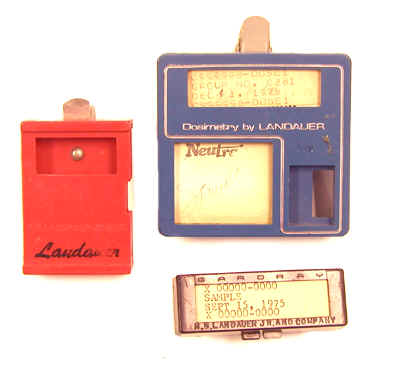Landauer Film Badges

The three film badges shown in the photograph were distributed by the R.S. Landauer Jr. and Company.
The red badge on the left, which probably dates from the 1960s, has slots on the sides for the insertion and removal of standard dental film packs. A green version of this badge (not shown) includes a Kodak "radia-tized" film pack that contains two films. The badge employs three circular metal filters of unknown composition to correct for the film's over-response to low energy photons.
The Gardray film badge towards the lower right, which takes the form of a tie clip, was given out as a sample and is dated Sept. 15, 1975. Landauer was one of the first, if not the first, to commercialize the use of film of non-standard dimensions.
The large blue badge uses film of the same dimensions as the Gardray dosimeter (located at the top of the badge) to evaluate beta, X-ray and gamma-ray exposures. It is dated Dec. 1, 1978.
The lower portion of the blue badge houses the "Neutrak" detector which consists of CR-39 (allyl diglycol carbonate) film. The neutron exposure is estimated by counting the tracks in the film which are made visible by etching in a chemical bath.
The tracks are produced in two ways. First, by the recoil protons (hydrogen nuclei) that result from fast neutron scattering in plastic. Second, by the alpha particles that result from slow neutrons interacting with boron-10.
Donated by Bob Boyd and Ron Kathren.
References
- Landauer advertisement, Health Physics Vol. 13 (1), January 1967.
- Landauer advertisement, Health Physics Vol. 30 (1), January 1976.
- Ron Kathren personal communication.
